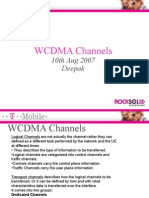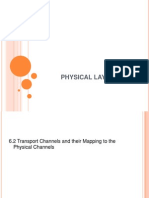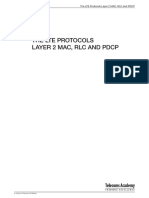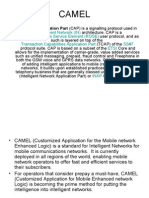S-72.2211 Mobile Communication Systems and Services: Umts & Utran
S-72.2211 Mobile Communication Systems and Services: Umts & Utran
Uploaded by
Amir Fakhry JunnyCopyright:
Available Formats
S-72.2211 Mobile Communication Systems and Services: Umts & Utran
S-72.2211 Mobile Communication Systems and Services: Umts & Utran
Uploaded by
Amir Fakhry JunnyOriginal Description:
Original Title
Copyright
Available Formats
Share this document
Did you find this document useful?
Is this content inappropriate?
Copyright:
Available Formats
S-72.2211 Mobile Communication Systems and Services: Umts & Utran
S-72.2211 Mobile Communication Systems and Services: Umts & Utran
Uploaded by
Amir Fakhry JunnyCopyright:
Available Formats
A!
Aalto University
Comnet
S-72.2211
Mobile Communication systems
and services
Lecture 12: WCDMA
Olav Tirkkonen
Department of Communications and Networking,
Aalto University
A!
2
UMTS & UTRAN
A!
3
UMTS Concept
Different core networks may operate with different Radio access
networks
Core Networks
GSM/GPRS core network
IS-41 core network (used in US; DAMPS, cdmaOne/IS-95)
IP core
Radio Access Networks
UTRA FDD (Wideband CDMA)
UTRA TDD (TD-CDMA)
UTRA TDD LCR (TDS-CDMA)
GERAN
Cdma2000 (multicarrier CDMA, standardized in 3GPP2)
Simultaneous Packet switched and circuit switched services
[Schiller 4.4 introduction]
A!
4
UMTS NW
GSM core for circuit switched, GPRS core for packet switched traffic
[Schiller 4.4.2; Holma-Toskala 5.1]
A!
5
UTRAN Network Elements
User Equipment (UE)
(UMTS) Subscriber Identity Module (SIM)
Radio Network Subsystem
Base Station (Node B)
Radio Network Controller (RNC)
Interface between RNCs to support soft handover
[Schiller 4.4.4 and 4.4.5]
A!
6
UMTS Services
[Holma-Toskala, Chapter 2]
A!
7
UMTS Bearer Services
UTRAN offers Radio Access Bearers to higher layers
UMTS offers UMTS Bearer Service, providing network
QoS
A!
8
UMTS Bearer QoS Classes
Traffi c class Conversional
cl ass
Streaming class Interactive class Background cl ass
Fundamental
characteristi cs
Preserves
time relations
between
information
entities
Conversational
pattern
Preserves
time relations
between
information
entities of
stream
Request-response
pattern
Preserve data
integrity
Destination not
expecting data
within certain time
Preserve data
integrity
Examples of
applications
Voice telephony
VoIP
Video telephony
Video games
Streaming
multimedia
Web browsing
Server access
Location based
services
Background e-mail
download
SMS, MMS
Data base
download
Conversational and streaming class are real-time services
Interactive and Background class are non-real-time (best effort
packet data) services
A!
9
UMTS Bearer Service Requirements
Real time/
constant delay
Non real time/variable
delay
Operating
environment
peak bit
rate
Del ay /
BER
peak bit
rate
Delay /
BER
Rural outdoor
MT speed 500
km/h
144
kbit/s
20 - 300 ms
10
-3
10
-7
144 kbit/s 150 ms
10
-3
10
-8
Urban/sub-urban
MT speed 120
km/h
384
kbit/s
20 - 300 ms
10
-3
10
-7
384 kbit/s 150 ms
10
-3
10
-8
Indoor/
short range outdoor
MT speed 10 km/h
2 Mbit/s 20 - 300 ms
10
-3
10
-7
2 Mbit/s 150 ms
10
-3
10
-8
A!
10
WCDMA (UTRA FDD) Air Interface:
Physical Resources
[Schiller 4.4.3]
A!
11
WCDMA Physical Channels
Duplexing: FDD
Carrier separation 5 MHz
an operator may operate multiple (5+5) carriers in parallel
each carrier is stand-alone
Multiplexing and Multiple Access: CDMA
all users use full cell bandwidth
chip rate 3.84 Mchips/s (bandwidth efficiency 0.768)
pulse shape: root-raised cosine, roll-off 0.22
spreading code
channelization code
OVSF WH codes
scrambling code
a physical channel is primarily determined by a spreading code
(channelization + scrambling) on a carrier
A!
12
WCDMA Air Interface:
Physical Layer
[Schiller 4.4.3]
A!
13
WCDMA Spreading
Both DL and UL asynchronous and non-orthogonal between cells
DL in-cell synchronous by definition
Channelization: Walsh-Hadamard code, SF 4 512
separate users within cell, and channels/services to one user
Orthogonal channels
Cell-specific scrambling code
512 different scrambling codes used in the system
Randomization of non-orthogonal interference between cells
UL in-cell asynchronous
Channelization: Walsh-Hadamard code, SF 4 256
separate channels/services from one user
User-specific scrambling code
millions of different codes available
Randomization of non-orthogonal interference between users
A!
14
WCDMA Channel Coding & Modulation
FEC:
turbo code, punctured from mother code of rate 1/3
convolutional code
Modulation:
DL: QPSK, 2 bits per symbol
UL: two I/Q multiplexed channels using BPSK
min min
; ; 1/ 1.41
Rx
b S
o S
P
P Q d R T d
N R
A!
15
Frame Structure & Time Scales
chip symbol slot frame
Chip period is 1/3.84 MHz = 0.26 s
A slot is 2/3 ms, 2560 chips
5 symbols with SF=512
5*2^7 = 640 symbols with SF=4
A slot is the main physical layer operation unit
structure of some physical channels
A frame consists of 15 slots, 10 ms, 38400 chips
The channel rate may change on frame-to-frame basis
spreading factor
A frame is the main MAC layer operation unit
MAC sends data to PHY every 10 ms
A!
16
WCDMA Air Interface:
Channel Structure
[Schiller 4.4.3.1; Holma-Toskala 6.1-6.2; 7.1-7.3.4]
A!
17
Logical, Transport and Physical CH
Logical channels define what data is transmitted
functionalities required to operating a Mobile Communication
System
Transport channels define how data is transmitted
shared, dedicated, ...
Physical channels define on which physical resources
data is transmitted
A!
18
Logical, Transport and Physical CH II
L2 consists of
Radio Link Control (RLC)
Medium Access Control (MAC)
Transport channels are offered by PHY to MAC
A!
19
WCDMA Channel Mapping
A!
20
Logical Channels
Broadcast Control CHannel (BCCH)
broadcasting system and cell specific information
system specific parameters
Neighbor lists for hand-over purposes
Paging Control CHannel (PCCH)
Common Control CHannel (CCCH)
control information, when no connection established
Dedicated Control CHannel (DCCH)
control information, when connection is established
Common Traffic CHannel (CTCH)
point-to-multipoint channel for user information to all or group of users
Dedicated Traffic CHannel (DTCH)
Point-to-point user data
DL only
DL & UL
A!
21
Transport Channels
UMTS supports circuit and packet switched data on
equal footing
Dedicated transport channels
physical resources reserved for a user until further notice
optimized for circuit switching
Dedicated CHannel (DCH)
in UL & DL
supports fast power control and soft handover
rate adaptation
on frame-by-frame (10 ms) basis
Transport Format channel coding rate & spreading factor
may be multiple DCHs to/from one user, with different
characteristics
A!
22
Transport Channels II
Packet data transport channels
optimized for packet switching
Forward Access CHannel (FACH)
Fast access to control and small amounts and user data
Slow power control
Random Access CHannel (RACH)
Fast access to control and small amounts and user data
Slotted ALOHA & open loop power control
Downlink Shared CHannel (DSCH)
Fast access to packet data in DL
Channels may be rapidly reserved and released
Other Common Transport Channels
Optimized for specific logical channels, audible in whole cell
Broadcast CHannel (BCH)
Paging CHannel (PCH)
DL only
UL only
A!
23
WCDMA MAC
The charactreristics of a transport channel are dictated
by MAC as a Transport Format Indicator
Data rate, (code rate, spreading factor),
To support simultaneous circuit and packet switched
services flexibility needed in mapping from logical to
transport channels
A logical channel may be carried by many transport channels
A transport channel may carry many logical channels
The dedicated and packet data transport channels may
be used for both
logical traffic (both dedicated and common) channels
logical control (both dedicated and common) channels
The resulting MAC specification is complex
A!
24
Physical Channels
There are physical channels
corresponding to specific transport channels
to support measurements
to support the operation of certain transport channels
A!
25
Physical Channels II
Dedicated physical channels (DPCH)
Dedicated Physical Data CHannel (DPDCH)
user data, one or several per radio link
one or more DCH may be multiplexed to a DPDCH
Dedicated Physical Control CHannel (DPCCH)
L1/L2 internal control to support DCH operation
shares a spreading code with DPDCH
Physical channels carrying common transport channels
Primary Common Control Physical CHannel (P-CCPCH)
carriers BCH
Secondary Common Control Physical CHannel (S-CCPCH)
carries FACH and PCH
Physical Random Access CHannel
carries RACH
Physical Downlink Shared Channel
carries DSCH
DL only
UL only
DL & UL
A!
26
Physical Channels III
Common channels for measurement purposes
Common Pilot CHannel (CPICH)
predefined sequence (with cell-specific scrambling)
for channel estimation and handover measurements
Synchronization CHannel (SCH)
predefined cell-specific sequence
for cell search & handover measurements
Common channels associated with transport channels
Paging Indicator CHannel (PICH)
indicates the presence of paging message
Aquisition Indication CHannel (AICH)
responses to RACH
DL only
A!
Logical Control vs. Physical Control
Separate logical channels for dedicated traffic and control
Logical control carry signaling traffic from higher layer signaling protocols
One dedicated transport channel
MAC maps logical DTCH and DCCH to the DCH transport channel
Separate physical channels for dedicated traffic and control
DPDCH carries DCH data, including higher layer signaling
DPCCH carries physical & MAC layer internal control information
27
A!
28
Mapping of Physical Channels to
Physical Resources
[Schiller 4.4.3.1]
A!
CDM Channels
A physical channel is a selection of a
a carrier frequency
a spreading code (channelisation & scrambling code)
in addition, time (inside slot) & phase (I/Q branch) are used to separate dedicated control
and dedicated traffic inside a spreading code
Common Pilot CHannel (CPICH)
one spreading code per cell
Primary Common Control Physical CHannel (P-CCPCH)
one spreading code per cell
Secondary Common Control Physical CHannel (S-CCPCH)
one spreading code per cell
Physical Random Access Channel
one spreading code per cell
Dedicated physical channels (DPCH)
one spreading code per user
Easy to add and remove channels depending on load
29
DL only
UL only
DL & UL
A!
30
UL DCH Mappings
Audible interference caused to audio equipment if there
are discontinuous transmissions
To avoid this: DPDCH and DPCCH I-Q multiplexed
DPCCH designed for continuous transmission with large SF
A!
31
DL DCH Mapping
DPCCH carries information about
Transmission Power Control (TPC)
Transport Format Combination Indicator (TFCI)
which transport channels are active and what are their transport formats
Dedicated pilot signals
DPCCH and DPDCH are time multiplexed within slot
During DTX, no DPDCH transmission
No audible interference as common channels transmit all the time
QPSK modulation
A!
32
WCDMA Bit Rates Offered by
Physical Layer
A!
33
WCDMA DL Bit Rates
Bit rates experienced on DPDCH (QPSK modulation)
DPCCH eats from the bit rate
Multicode transmission (multiple DPDCHs) to increase data rate
up to 3 QSPK channels with SF 4
SF Symbol rate
(ksym/s)
Bit rate
(kbit/s)
DPDCH bit rate
(kbit/s)
User rate with rate
channel code
512 7.5 15 3-6 1-3 kbps
256 15 30 12-24 6-12 kbps
128 30 60 42-51 20-24 kbps
64 60 120 90 45 kbps
... ... ... ... ...
8 480 960 912 456 kbps
4 960 1920 1872 936 kbps
4; 3 codes 2880 5760 5616 2.3 Mbps
A!
34
WCDMA UL Bit Rates
Bit rates experienced on DPDCH (BPSK modulation)
e.g. 3.84 Mchips/s / 256 = 15 ksymbols/s
Multicode transmission (multiple DPDCHs) to increase data rate
up to 6 BSPK channels with SF 4 (4 on I-branch, 2 on Q-branch)
SF Symbol rate
(ksym/s)
DPDCH bit rate
(kbit/s)
User rate with rate
channel code
256 15 15 7.5 kbps
128 30 30 15 kbps
64 60 60 30 kbps
32 120 120 60 kbps
16 240 240 120 kbps
8 480 480 240 kbps
4 960 960 480 kbps
4; 6 codes 5740 5740 2.3 Mbps
A!
35
WCDMA Air Interface:
RRM
[Holma-Toskala, 3.5; 3.6; 9.1; ]
A!
36
WCDMA RRM
Intra-cell
Fast transmission power control
Link adaptation (adaptive coding)
Inter-cell
Frequency Reuse 1
Scrambling
Load & admission control
Soft handover
A!
37
Frequency Reuse 1
WCDMA operates with 5 MHz frequency in all cells
Reuse 1 is possible as WCDMA physical layer tolerates more
interference than GSM
stronger FEC lower SIR requirement
CDMA scrambling randomizes inter-cell interference
Load & admission control takes care of distribution of
resources between cells
Control the aggregate level of interference
C.f. fractional load
Flexible resource usage, easier network planning
High spectral efficiency
A!
38
Power Control
Closed loop (fast) power control
on dedicated channels
essential in UL due to near-far effect
one TPC command per 2/3 ms time slot
adjust power to keep SIR target
Outer loop power control
adjusts SIR target based on history
Open loop power control
for RACH
Trial and error: ramp up power until you are heard
UL only
DL & UL
A!
39
Handover
Soft handover
used on dedicated channels
active set of BSs defined by network, all serve the user
DL
all BSs in active set send the same signal
MS demodulates and coherently combines signals
maximum ratio combining
UL
BSs in active set receive and demodulate signal
selection combining used in network
Softer handover
special case of soft handover between sectors in same BS site
coherent combining also in UL
A!
40
WCDMA Protocols
[Holma-Toskala 7.1; 7.2]
A!
41
UMTS Packet Data Protocols
Protocols tunneling data from external packet network to MS
GTP: GPRS Tunneling Protocol
between GGSN and SGSN and SGSN and RNC
Protocols within RAN, between RNC and MS
PDCP, Packet Data Convergence Protocol
IP header compression
RLC
Segmentation, ciphering
Acknowledged / unacknowledged / transparent mode
ARQ: yes/no/no; error detection: yes/yes/no
MAC
Dedicated MAC (MAC-d)
multiplexing and priority handling of logical channels of a single MS
Common/shared MAC (MAC-c/sh)
multiplexing and priority handling of multiple MSs sharing the
DSCH
Protocol between BS and MS
PHY
A!
42
UMTS Protocol Architecture
PS domain, User Plane
Difference to GPRS: GTP to RNC, LLC vanished
You might also like
- From GSM to LTE-Advanced Pro and 5G: An Introduction to Mobile Networks and Mobile BroadbandFrom EverandFrom GSM to LTE-Advanced Pro and 5G: An Introduction to Mobile Networks and Mobile BroadbandNo ratings yet
- Indoor Radio Planning: A Practical Guide for 2G, 3G and 4GFrom EverandIndoor Radio Planning: A Practical Guide for 2G, 3G and 4GRating: 5 out of 5 stars5/5 (1)
- Introduction To Long Term Evolution (Lte) - Part2: Prepared By: Kapil KumarDocument43 pagesIntroduction To Long Term Evolution (Lte) - Part2: Prepared By: Kapil Kumarabhipareek17No ratings yet
- UMTS Channel PDFDocument47 pagesUMTS Channel PDFsayemboNo ratings yet
- Next Generation Networks (The Radio Aspect)Document53 pagesNext Generation Networks (The Radio Aspect)omer449100% (1)
- Physical Channels: Control ChannelDocument13 pagesPhysical Channels: Control ChannelAnshul GuptaNo ratings yet
- WCDMA Channels & Channel SwitchingDocument26 pagesWCDMA Channels & Channel SwitchingDee OyeNo ratings yet
- WCDMA Channels: 10th Aug 2007 DeepakDocument40 pagesWCDMA Channels: 10th Aug 2007 DeepakkhurshidNo ratings yet
- Third Gen. Mobile N/WKS: Radio Interface Fixed Networks (NSS) UMTS Core Networks Towards Fourth GenDocument35 pagesThird Gen. Mobile N/WKS: Radio Interface Fixed Networks (NSS) UMTS Core Networks Towards Fourth GenAnkita SinghNo ratings yet
- WCDMA Physical LayerDocument194 pagesWCDMA Physical LayervmadanNo ratings yet
- Wcdma Channel ConceptDocument18 pagesWcdma Channel Conceptneelachal100% (1)
- UTRAN Radio Interface ProtocolsDocument31 pagesUTRAN Radio Interface ProtocolsDpkKSinghNo ratings yet
- UMTS Air InterfaceDocument58 pagesUMTS Air Interfaceluthra12345100% (1)
- LTE Radio ChannelsDocument9 pagesLTE Radio ChannelsJakir HossainNo ratings yet
- 14 WcdmaDocument36 pages14 WcdmaAnonymous mnROB81No ratings yet
- Hiperlan (High-Performance Local Area Network)Document40 pagesHiperlan (High-Performance Local Area Network)Prabha KaranNo ratings yet
- Ieee 802.11Document49 pagesIeee 802.11Jyoti ShekharNo ratings yet
- 3G ChannelsDocument6 pages3G ChannelsAmit BasraNo ratings yet
- E1-E2 - Text - Chapter 2. GSM Gprs Logical Channels and CallDocument16 pagesE1-E2 - Text - Chapter 2. GSM Gprs Logical Channels and Callmayank guptaNo ratings yet
- WCDMA Channels: 10th Aug 2007 DeepakDocument40 pagesWCDMA Channels: 10th Aug 2007 DeepakHammad PrinceNo ratings yet
- LTE ChannelDocument11 pagesLTE ChannelNam Song Hau CTONo ratings yet
- Lecture7 RadioInterfaceProtcolsDocument31 pagesLecture7 RadioInterfaceProtcolsRajveer SinghNo ratings yet
- Umts Chap6Document33 pagesUmts Chap6Ghassen Gaston KannouNo ratings yet
- By - Manish SrivastavaDocument19 pagesBy - Manish SrivastavaRahul DubeyNo ratings yet
- Wcdma Channels: by - Manish SrivastavaDocument19 pagesWcdma Channels: by - Manish SrivastavaMostafizaktelNo ratings yet
- UMTS Optimization PDFDocument167 pagesUMTS Optimization PDFYoussef Fouad100% (2)
- Wcdma Channels: by - Manish SrivastavaDocument19 pagesWcdma Channels: by - Manish SrivastavakikirnNo ratings yet
- WCDMA Physical Layer Design: A. ChockalingamDocument59 pagesWCDMA Physical Layer Design: A. ChockalingamSantosh GuptaNo ratings yet
- 3G LTE Channel TypesDocument3 pages3G LTE Channel TypesAvneesh DubeyNo ratings yet
- The LTE Protocols Layer 2 MAC, RLC and PDCPDocument41 pagesThe LTE Protocols Layer 2 MAC, RLC and PDCPJJamesranNo ratings yet
- Third Gen. Mobile N/WKS: Radio Interface Fixed Networks (NSS) UMTS Core Networks Towards Fourth GenDocument35 pagesThird Gen. Mobile N/WKS: Radio Interface Fixed Networks (NSS) UMTS Core Networks Towards Fourth GenV SharmaNo ratings yet
- Lte 5GDocument10 pagesLte 5GRaghuram MahataNo ratings yet
- Wcdma ChannelsDocument19 pagesWcdma ChannelsRitesh RanjanNo ratings yet
- Umts Chap6Document33 pagesUmts Chap6Shafath AliNo ratings yet
- Wcdma Channels: by - Manish SrivastavaDocument19 pagesWcdma Channels: by - Manish SrivastavaaslamsatnaNo ratings yet
- UMTS - RLC and MAC Layer in DetailDocument126 pagesUMTS - RLC and MAC Layer in DetailCaymennNo ratings yet
- Overview of LTE Physical LayerDocument13 pagesOverview of LTE Physical LayerRamy .. MarianNo ratings yet
- UMTS Chap6Document33 pagesUMTS Chap6NguyenDucTaiNo ratings yet
- Physical Layer: SasasaasasDocument33 pagesPhysical Layer: SasasaasasNguyenDucTaiNo ratings yet
- 2 UMTS Radio Interface Physical LayerDocument56 pages2 UMTS Radio Interface Physical LayerKuldeep KashyapNo ratings yet
- Physical Layer: SasasaasasDocument33 pagesPhysical Layer: SasasaasasNguyenDucTaiNo ratings yet
- The Internet of Things: Key Applications and ProtocolsFrom EverandThe Internet of Things: Key Applications and ProtocolsRating: 5 out of 5 stars5/5 (1)
- Practical Guide to LTE-A, VoLTE and IoT: Paving the way towards 5GFrom EverandPractical Guide to LTE-A, VoLTE and IoT: Paving the way towards 5GNo ratings yet
- Radio Access Networks for UMTS: Principles and PracticeFrom EverandRadio Access Networks for UMTS: Principles and PracticeRating: 5 out of 5 stars5/5 (1)
- Radio Spectrum Management: Policies, Regulations and TechniquesFrom EverandRadio Spectrum Management: Policies, Regulations and TechniquesNo ratings yet
- Radio Control for Model Ships, Boats and AircraftFrom EverandRadio Control for Model Ships, Boats and AircraftRating: 5 out of 5 stars5/5 (1)
- Digital Mobile Communications and the TETRA SystemFrom EverandDigital Mobile Communications and the TETRA SystemRating: 5 out of 5 stars5/5 (1)
- IP Telephony: Deploying VoIP Protocols and IMS InfrastructureFrom EverandIP Telephony: Deploying VoIP Protocols and IMS InfrastructureNo ratings yet
- Wavelength Division Multiplexing: A Practical Engineering GuideFrom EverandWavelength Division Multiplexing: A Practical Engineering GuideNo ratings yet
- Chapter 7 - Wirless SecurityDocument40 pagesChapter 7 - Wirless SecurityzekariasNo ratings yet
- Super Wi-FiDocument9 pagesSuper Wi-FisaumyaNo ratings yet
- 01 Uniwoay GPS Watch QuotationDocument3 pages01 Uniwoay GPS Watch QuotationMarouane KetatNo ratings yet
- Jio Recharge Plans and Offers (March 2022) : Jio New Prepaid Recharge Plan Price List With Talktime, Validity, 4G Data BenefitsDocument12 pagesJio Recharge Plans and Offers (March 2022) : Jio New Prepaid Recharge Plan Price List With Talktime, Validity, 4G Data BenefitsManish SinghNo ratings yet
- 5G Wireless TechnologyDocument21 pages5G Wireless TechnologySakshi AgarwalNo ratings yet
- A11yprovider LogDocument169 pagesA11yprovider LogMadrYxNo ratings yet
- Audio TranscriptDocument4 pagesAudio TranscriptMohassan SalebanNo ratings yet
- Parameter Setting For 3G To 2G HO in EDocument2 pagesParameter Setting For 3G To 2G HO in ESatish KumarNo ratings yet
- Apple Watch: User OnboardingDocument115 pagesApple Watch: User Onboardingabey.mulugetaNo ratings yet
- Aerohive Datasheet AP130Document2 pagesAerohive Datasheet AP130Edson GriaNo ratings yet
- Phones and Tablets For Android 11Document8 pagesPhones and Tablets For Android 11calcium nitrateNo ratings yet
- Mobile Cocooning How Growing Reliance On Smart Devices Is Influencing Consumer BehaviourDocument83 pagesMobile Cocooning How Growing Reliance On Smart Devices Is Influencing Consumer BehaviourChi MaiNo ratings yet
- Camel Application Part-By Abhinav Kumar & VASDocument20 pagesCamel Application Part-By Abhinav Kumar & VASaviblueNo ratings yet
- Physics Presentation (Invention of 4G)Document18 pagesPhysics Presentation (Invention of 4G)lim chuan yangNo ratings yet
- Home Screen Publishing: Mobile Advertising Done RightDocument19 pagesHome Screen Publishing: Mobile Advertising Done RightarmyperryNo ratings yet
- 1 4945163814912917563-1Document7 pages1 4945163814912917563-1albert0% (1)
- Volte Strategy From MavenirDocument20 pagesVolte Strategy From MavenirRajib BashirNo ratings yet
- RAT - Frequency Selection Priority Index - RFSP IndexDocument2 pagesRAT - Frequency Selection Priority Index - RFSP IndexSouheir EidoNo ratings yet
- AirPrime EM7511 Product Specification r7Document101 pagesAirPrime EM7511 Product Specification r7jacobbowserNo ratings yet
- 1321 Wintego Brochure PDFDocument2 pages1321 Wintego Brochure PDFGustavo SánchezNo ratings yet
- Imei OfflineDocument2 pagesImei OfflineVivien FitriannaNo ratings yet
- F8936-L Series Router Technical Specification V1.0.1Document5 pagesF8936-L Series Router Technical Specification V1.0.1Xiamen Four-Faith Industrial Router supplierNo ratings yet
- Nokia Secret CodesDocument6 pagesNokia Secret CodesKhaleeq Uz ZamanNo ratings yet
- Best Fitness Devices To Complement Your Carb Manager MembershipDocument34 pagesBest Fitness Devices To Complement Your Carb Manager Membershiplavi2603No ratings yet
- Circuit Switched Fallback CSFBDocument6 pagesCircuit Switched Fallback CSFBMalikMDNuraniNo ratings yet
- Megatrends in PeruDocument58 pagesMegatrends in PeruKarla CárdenasNo ratings yet
- Neuroanatomia Pintar para Aprender PDF 3 PDF FreeDocument125 pagesNeuroanatomia Pintar para Aprender PDF 3 PDF Freeesquilo803No ratings yet
- Seminar Report - 4g Wireless TechnologyDocument35 pagesSeminar Report - 4g Wireless TechnologyAbdul WadoodNo ratings yet
- What Is InCallUI How Does It Work - QuoraDocument1 pageWhat Is InCallUI How Does It Work - QuoraFahmi Ramadhan Salayan0% (1)
- Network Field Tests: Walk & Drive Test GuideDocument23 pagesNetwork Field Tests: Walk & Drive Test Guide2000omotoNo ratings yet

























































































